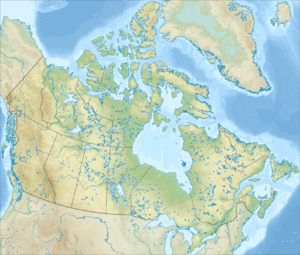Kazan River
| Kazan River | |
|
Kazan Falls, on the lower Kazan River, Nunavut
|
|
| Country | Canada |
|---|---|
| Source | Kasba Lake |
| - location | Northwest Territories |
| - coordinates | 60°34′22″N 102°08′47″W / 60.57278°N 102.14639°W |
| Mouth | Baker Lake |
| - location | near Chesterfield Inlet, Kivalliq Region, Nunavut |
| - coordinates | 64°2′30″N 95°29′5″W / 64.04167°N 95.48472°WCoordinates: 64°2′30″N 95°29′5″W / 64.04167°N 95.48472°W |
| Length | 1,000 km (621 mi) |
| Basin | 71,500 km2 (27,606 sq mi) |
The Kazan River (Inuktitut Harvaqtuuq,Inuktitut syllabics ᓴᕐᕙᖅᑑᖅ; meaning "strong rapids", "the big drift" or "place of much fast flowing water"), is a Canadian Heritage River located in Nunavut, Canada. The Dene name for the river was Kasba-tue meaning “white partridge river.” The name was apparently changed to Kazan in the late 19th century due to the influence of Order of Mary Immaculate missionaries. The river headwaters are in northern Saskatchewan at Kasba Lake, and it flows north for about 1000 km (621 mi) before emptying into Baker Lake (64°09′00″N 95°30′00″W / 64.15000°N 95.50000°W), on the opposite side of the mouth of the Thelon River. Along its course the river flows through several lakes, including Ennadai Lake and Yathkyed Lake, over the Kazan Falls (25 m (82 ft)), down a red sandstone gorge and through both boreal forest and tundra. It is the last section of the river, below Ennadai Lake, that is above the timber line and is designated a Canadian Heritage River.
Although many species of wildlife may be observed along the river, it is the barren-ground caribou (Qamanirjuaq and Beverly herds) for which it is most well known. Over 300,000 caribou migrate through the area and it is said to be the largest migration of any land animal. Other wildlife that may be observed in the area include muskox, wolverine, peregrine falcon and many species of fish.
...
Wikipedia


